Authentic German Maultaschen
This post may contain affiliate links. See my disclosure policy.
An Authentic Homemade Maultaschen recipe just the way you know and love them from Germany! Save time by making and freezing the meat filling in advance, following our tips about the pasta dough, and make a double batch while you’re at it and freeze the Maultaschen so you can grab, thaw and cook them whenever the craving comes calling!
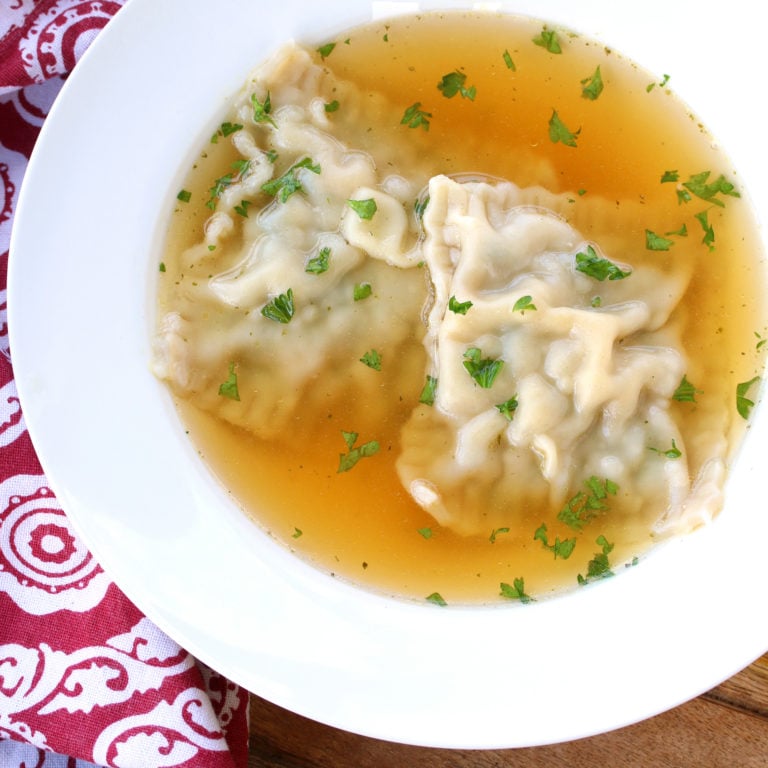
Homemade Maultaschen
As any Swabian will tell you, the Swabia region has the best cuisine in all of Germany. It’s true. And just one of many examples is Maultaschen…those wonderful pasta pockets filled with deliciously spiced meat, bread, onions and spinach. They’re Germany’s version of raviolis and they’re absolute heaven!
Maultaschen has always been one of my favorite German dishes and it’s something I frequently ordered when my family went out to eat in restaurants throughout southern Germany. Being from Stuttgart it was almost guaranteed that I would find them on every German restaurant’s menu. Now that I’ve moved to the U.S. it’s virtually impossible to find them. And if you do find them chances are they don’t taste like the real thing. And that’s why I make my own. These authentic homemade Maultaschen are the real deal. They taste just like the Maultaschen you know and love from Germany!
Where Did Maultaschen Originate?
Maultaschen have a long history and were traditionally associated with Lent, during which Catholics were to refrain from eating meat. The purpose in creating these pasta pockets was to sneak the meat inside of them thereby concealing it from the eyes of God. In this way the carnivorous Catholics could have their meat fix without calling down the lightning from heaven. In fact, there’s a Swabian nickname for Maultaschen, Herrgottsbescheißerle, which means “small God-cheaters.” And there you have it.
It is believed that Maultaschen were first created in the 17th century by the unruly Cistercian monks of the Maulbronn Abbey in the town of Maulbronn for that very purpose. The abbey is not far from where I grew up in Stuttgart. I’ve been there and I have to report that I found no trace of Maultaschen on its premises. But to be fair 500 years has a way of covering up such perishable evidence. So I’m happy to accept the tradition and give the monks full credit for this delicious dish that has since received official EU recognition as a regionally-protected speciality.
There are a few meanings attributable to the name Maultaschen (ie, maul means “mouth,” taschen means “pockets”) but the term Maul is commonly thought to have derived from the town of Maulbronn (Maultaschen being the shortened version of Maulbronn Taschen) and Taschen translates as “pockets,” describing the filled pasta.
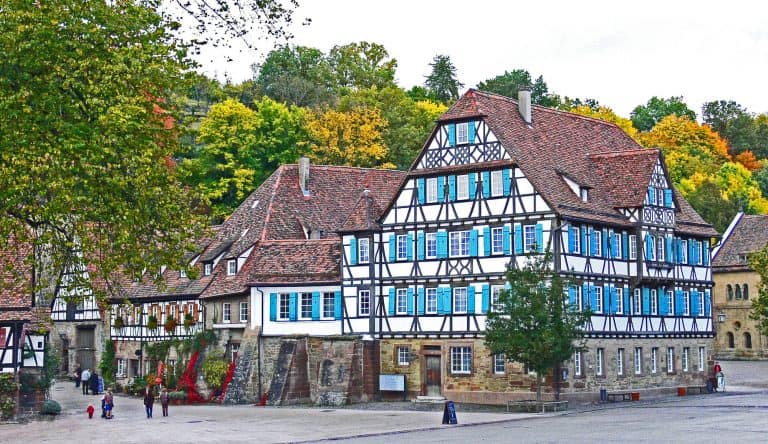

What is Bratwurstbrät?
One of the key ingredients in traditional Maultaschen is what’s called “Bratwurstbrät” in Germany. Without it you simply cannot replicate an authentic flavor.
Authentic German recipes usually call for a combination of ground meat (most commonly ground beef) and something called Bratwurstbrät. It’s the meat mixture that’s used to make German bratwursts (yes, we have a recipe for those too!). In Germany, like bulk Italian or bulk breakfast sausage, you can go to the butcher and get Bratwurstbrät. The challenge is that outside of Germany it’s nearly impossible to find.
And so I’ve developed a recipe for homemade Bratwurstbraet combined with the ground beef to make the Maultaschen filling. And it tastes exactly like the genuine stuff in Germany. Problem solved.
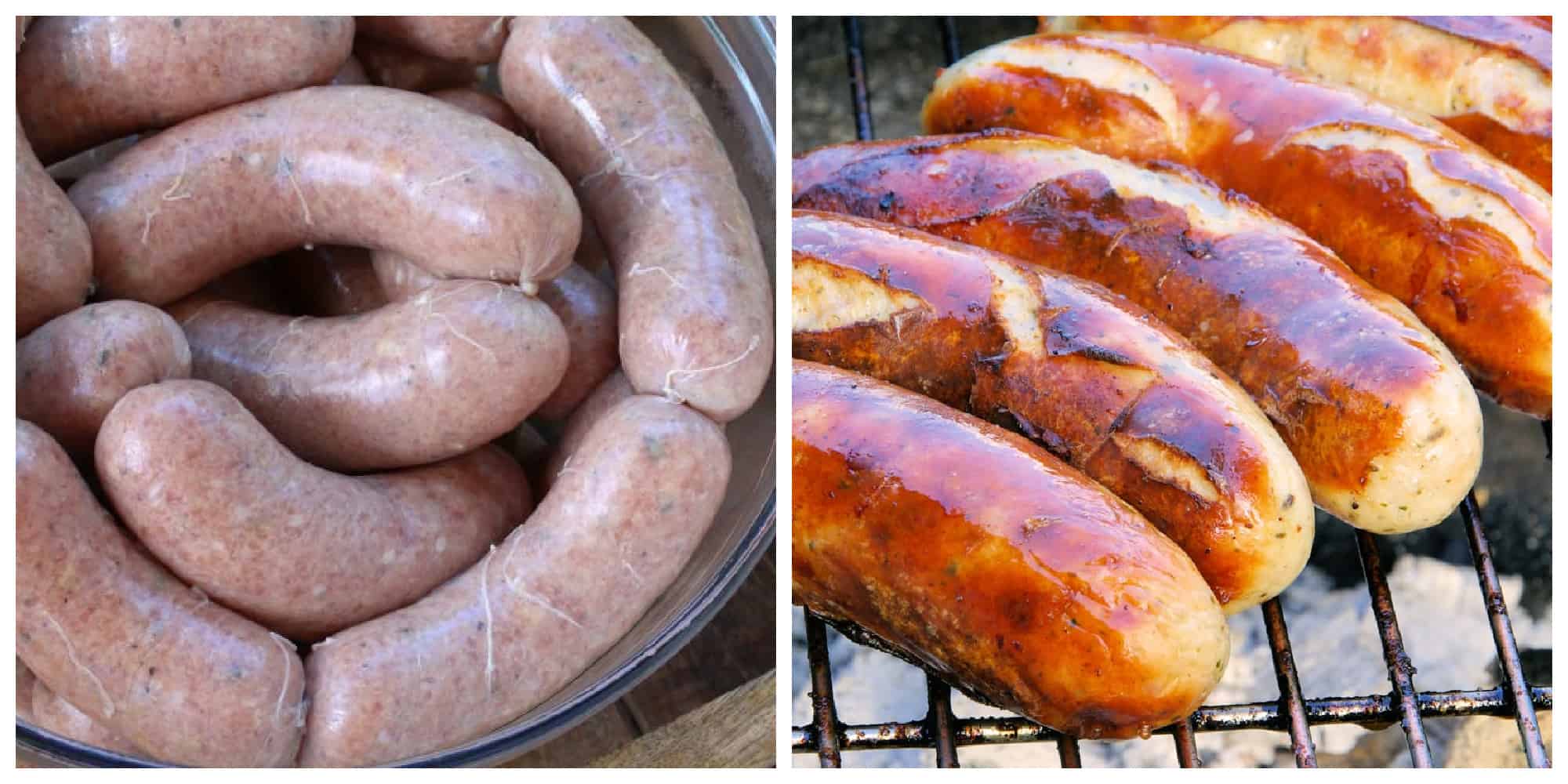
How To Make Bratwurstbrät
Technically, if you can find authentic German Bratwursts you could cut them and squeeze the filling out of them and use that for the Maultaschen filling (in place of the ground pork) along with ground beef. But all of the Bratwursts I’ve found here in the U.S. either taste nothing like authentic German Bratwursts or, in the case of imported ones that I’ve seen, they are pre-cooked so the filling can’t be used.
I’ve developed a recipe for homemade Bratwurstbraet that is combined with the ground beef to make the Maultaschen filling and it tastes exactly like the stuff you’ll find in Germany. Fry a little up and taste it and you’ll recognize the flavor as tasting just like authentic German Bratwursts. This is the filling I use to make my own German Bratwursts with the addition of a few other ingredients needed for the Bratwursts specifically. My Maultaschen filling will enable you to create those authentic-tasting Maultaschen that you know and love from Germany!
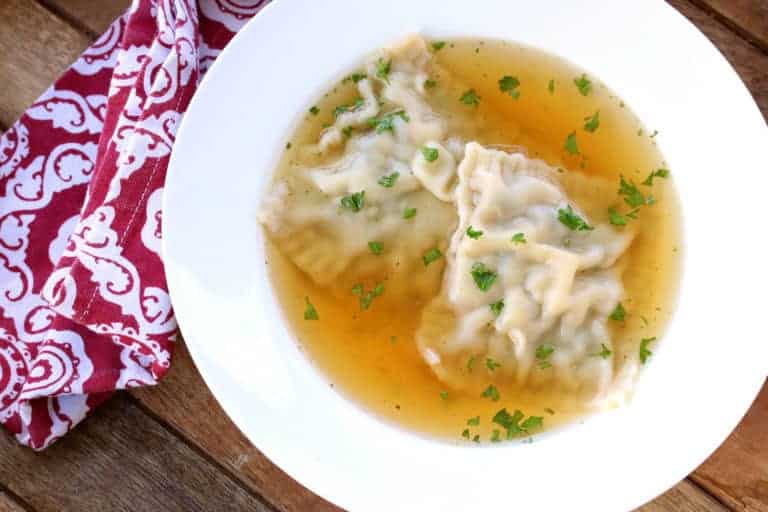
Make Sure the Meat Is Properly Mixed/”Emulsified” for the Right Texture
If you don’t have a stand mixer then don’t worry about this. But if you do and you’re determined to get the right texture, the key is making sure you adequately mix the meat until it is what’s called “emulsified”. Meaning if you take a clump of meat and pull it apart with your fingers you should see tiny threads pulling apart. This is the texture needed for making sausages and is what results in a smooth texture. Otherwise you’ll end up with a filling that is more crumbly in texture.
Is There a Shortcut?
Yes, you can use pre-ground meat from the store/butcher, half ground beef and half ground pork. You won’t have any control over the muscle-to-fat ratio so the texture won’t be as smooth but once you add the spices to it it should at least taste the same. Depending on the fat content of the ground meat (if the fat content is too low) it may not emulsify properly when you mix it in the stand mixer. But again, if you’re not too concerned about achieving the perfect texture and are more concerned just about achieving the perfect flavor, you don’t need to worry about that. The perfect texture aspect can be left to German food diehard types like me ;)
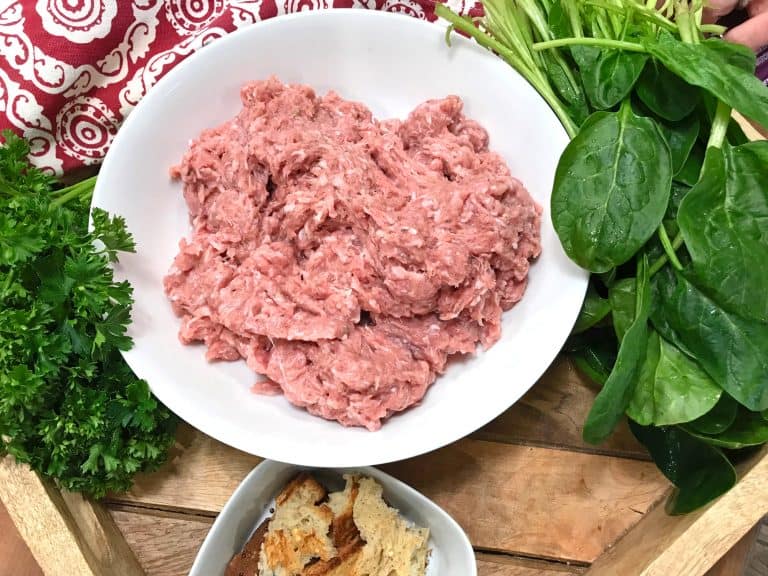
Maultaschen Recipe
Let’s get started!
If you’re using pre-ground beef and pork from the store, skip this step.
If you’re grinding your own meat, pork shoulder is an ideal cut because it has a good ratio of fat to muscle. Also when choosing a cut of beef (I get whatever’s on sale) don’t be afraid if it’s a fatty cut. That fat will help bind the meat when you mix it to create the ideal texture.

To make the Maultaschen filling, place the ground pork and beef, spices and milk powder in the bowl stand mixer fitted with a paddle attachment. Add about 1/2 cup crushed ice to the ground meat mixture in the stand mixture. This will keep the meat cold and prevent the fat from melting as the mixture is mixed/emulsified to create the desired texture.
Mix the meat on low-medium speed for a few minutes (be careful not to over-mix) until the mixture is emulsified. Meaning if you take a clump of meat and pull it apart with your fingers you should see tiny threads pulling apart.
Note: If you’re using pre-ground store-bought beef and pork it may not emulsify properly because of a lower fat content, in which case don’t worry about it and just move on to the next step.
Note: You can use the meat mixture immediately or you can freeze it so you can have it on hand for convenience to save time when you’re ready to make another batch of Maultaschen.
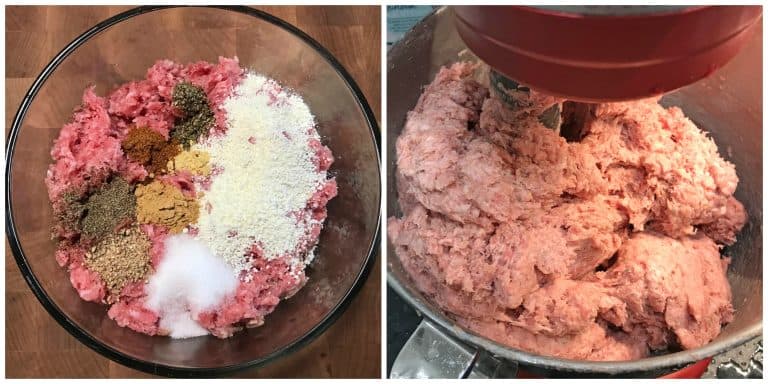
Now let’s prepare the other ingredients for the Maultaschen filling:
Boil the spinach for 1-2 minutes. Drain and rinse under cold water, thoroughly squeeze out the water and very finally chop it.
In a frying pan, heat the butter and saute the onion until soft and translucent, 5-7 minutes. Add the garlic and parsley and cook for another minute or two. Let the mixture cool down so it’s not super hot.
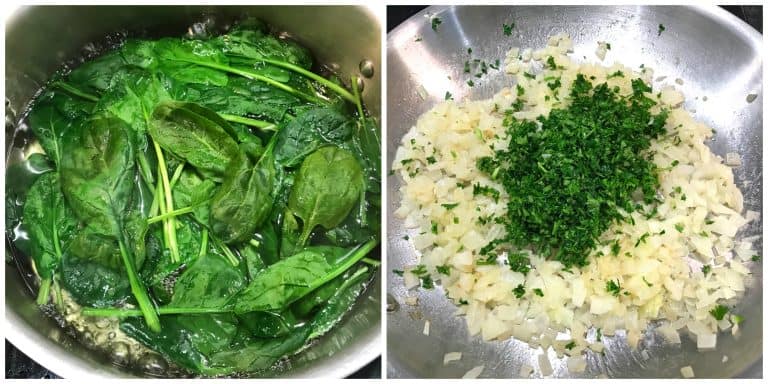
Put the meat mixture in a large bowl along with the onion/parsley mixture, the chopped spinach, prepared breadcrumbs, spices and eggs. Use a stand mixer or your hands to thoroughly combine the mixture.
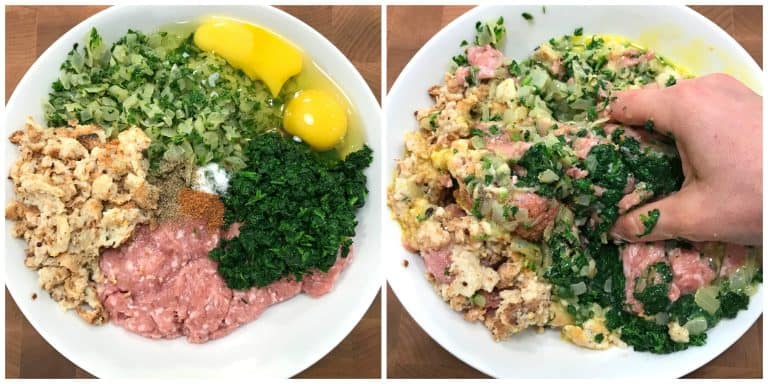
*NOTE: If you prefer an even finer texture you can run about one third or so of this mixture through the blender and then stir it back in to the rest of the mixture.
For the dough you can either use prepared sheets of pasta dough or you can use a shortcut: Wonton wrappers! Wonton wrappers are just basic pasta dough (flour, eggs, water) and they’re already pre-cut into just the right sized squares which makes them super convenient. And unless you have your own pasta machine and make your own sheets of pasta dough, wonton wrappers are WAY cheaper than store-bought fresh pasta sheets. My verdict: Wontons wrappers = Convenient, Easy, Cheaper & Taste the Same. Win-win!
I tend to be a traditionalist when it comes to preparing authentic dishes but if there are modern shortcuts that save time and effort and achieve the same results then I’m all for them!
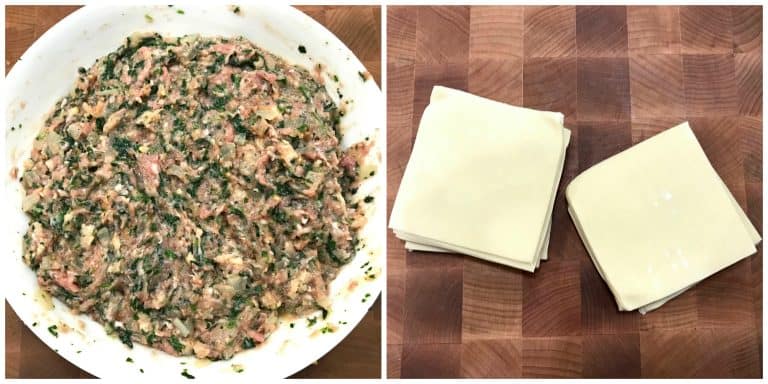
Place a small spoonful of Maultaschen filling on a square of pasta dough (about 3 1/2 x 3 1/2) leaving about 1/4 inch of space from the edges. Brush the edges with the egg, place another pasta square on top and press down with your fingers to seal.
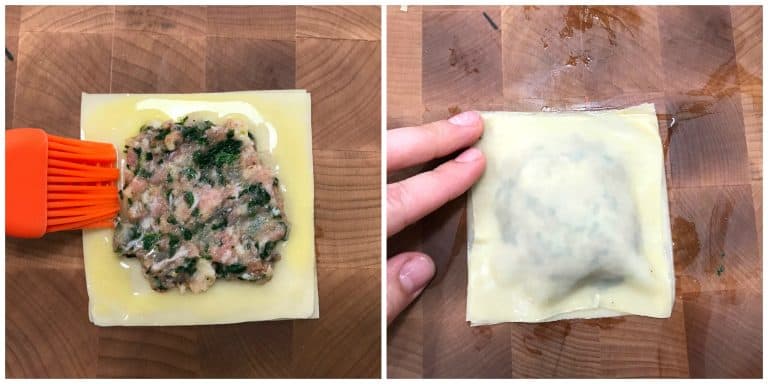
To ensure the edges are sealed tightly you can either use a fork to press the edges together or use a fluted pastry/pasta cutter wheel to make pretty edges.
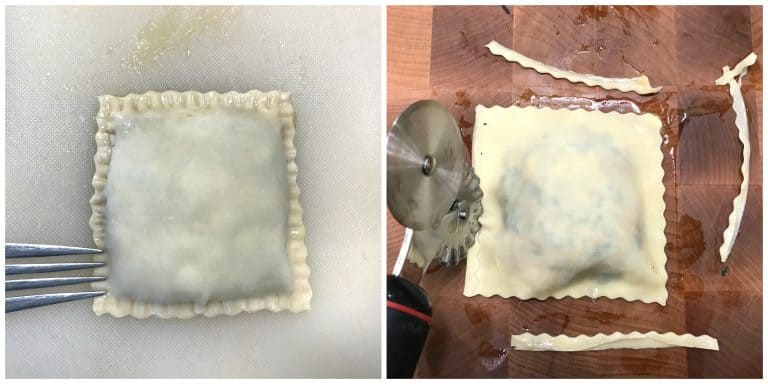
How to Freeze Maultaschen: For convenience you can freeze the Maultaschen at this point. Lay them out in a single layer on a lined cookie sheet and freeze them. Once frozen remove them and put them in an airtight container or ziplock bag and freeze for up to 3 months.
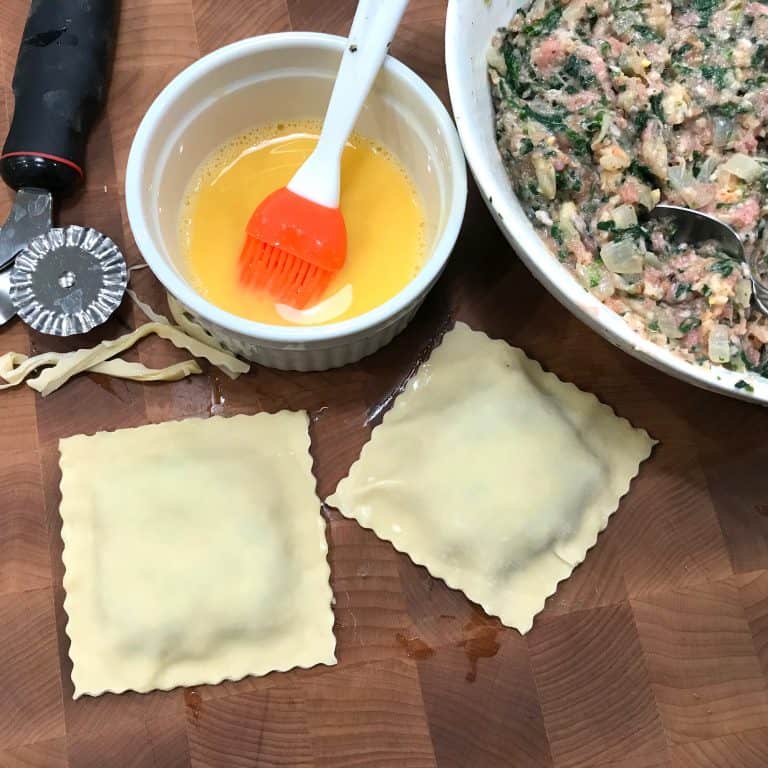
Now it’s time to cook the Maultaschen. Bring a large pot of lightly salted water to a low boil. Working in batches so as to not overcrowd, place the Maultaschen in the pot and keep the water at a very gentle simmer. Simmer for 10-15 minutes.
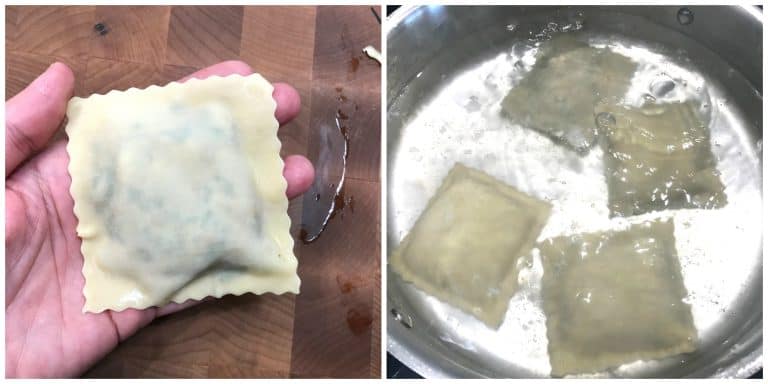
Remove the Maultaschen with a slotted spoon and transfer them to a colander to drain. Store them in an airtight container in the fridge until ready to use. They’ll keep for up to 3 days.
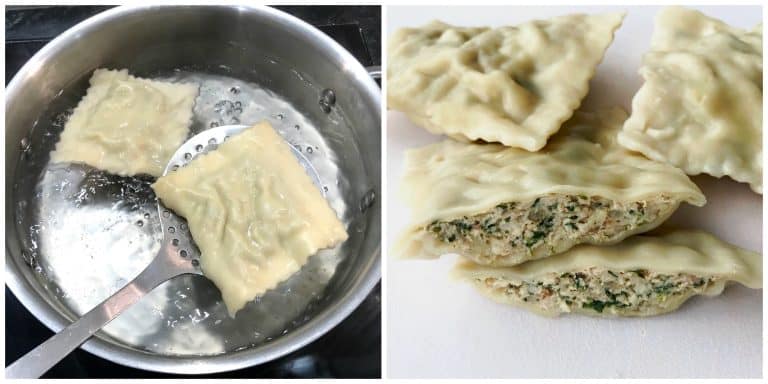
Can You Freeze Maultaschen?
Yes, Maultaschen can be frozen before they’re cooked. Make a double or triple batch while you’re at it so you can have Maultaschen on hand whenever the craving comes calling! After you fill the pasta and seal the Maultaschen shut, lay them out in a single layer on a lined cookie sheet and freeze them. Once frozen remove them and put them in an airtight container or ziplock bag and freeze for up to 3 months.
How To Serve Maultaschen
The ways are limited only by your imagination! The four most popular ways you’ll find them served in German restaurants are:
- Maultaschen in der Brühe: Served in broth (usually beef broth) and eaten as a soup.
- Geschmälzte Maultaschen: Fried in butter and served topped with caramelized onions)
- Gebratene Maultaschen mit Ei: The Maultaschen are sliced and fried in butter with beaten egg and herbs.
- Maultaschen Schweizer Art (Swiss style): Whole Maultaschen are baked with ham and Swiss cheese on top.
All four of these ways are popular and absolutely delicious. I encourage you to try them all!
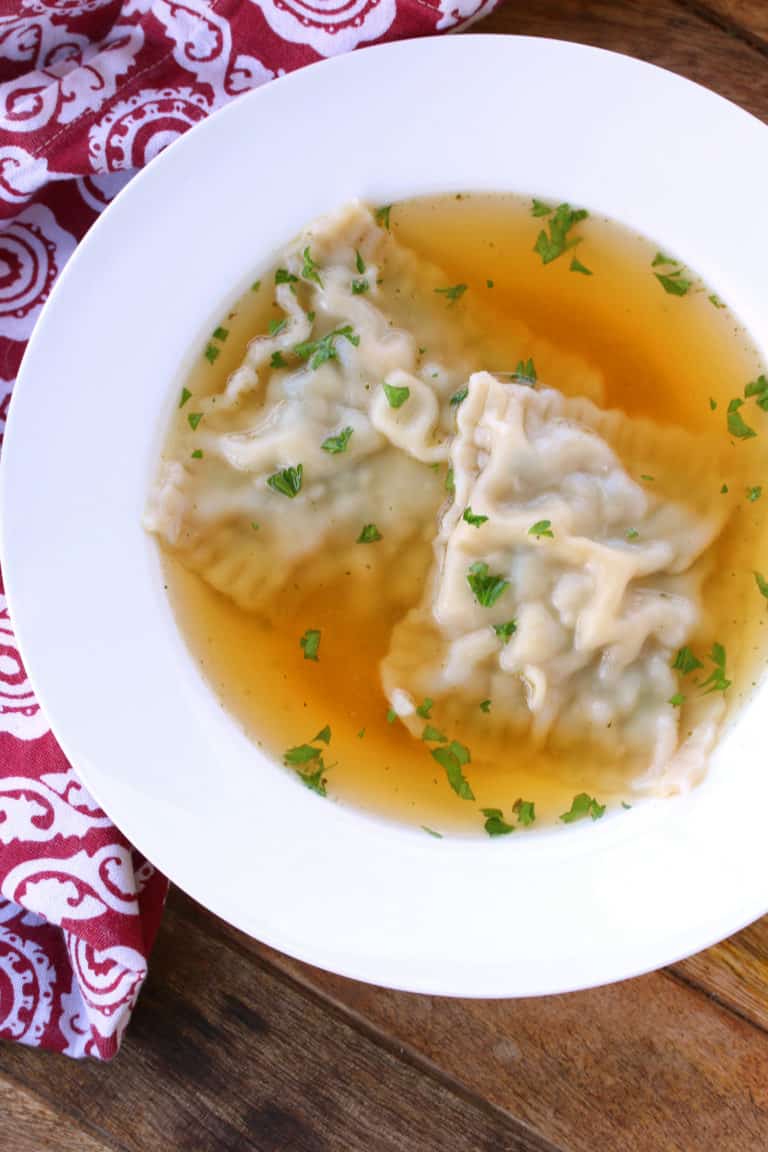
For more Authentic German Recipes to try my:
- Spätzle
- Käsespätzle
- Schnitzel
- Jägerschnitzel
- Sauerbraten
- Rouladen
- Schweinshaxe
- Königsberger Klopse
- German Potato Soup
- German Sauerkraut Soup
- German Potato Salad
- Currywurst
- Semmelknödel
- German Potato Dumplings
- Kartoffelpuffer
- German Plum Cake
- Vollkornbrot
- Rotkohl
- Zwiebelkuchen
Save This Recipe
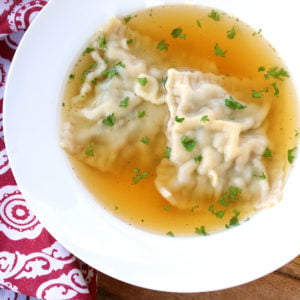
Authentic German Maultaschen
Ingredients
- 1 1/2 pounds fresh pasta sheets , cut into approx 3 1/2 x 3 1/2 inch squares
- OR 52 wonton wrappers , look for ones that contain egg in the ingredients (this is quicker, easier and tastes exactly the same *see blog post for more info)
- 1/2 pound ground pork (see note about grinding your own meat)
- 1/2 pound ground beef (see note about grinding your own meat)
- 1 1/4 teaspoons salt
- 1/2 teaspoon white pepper , freshly ground
- 1/4 teaspoon black pepper , freshly ground
- 1/3 teaspoon ground mace (can substitute nutmeg but strongly recommend mace for traditional German flavor)
- 1/3 teaspoon ground ginger
- 1/3 teaspoon dried marjoram
- 1/4 teaspoon mustard powder
- 1/8 teaspoon ground cardamom
- 1/8 teaspoon ground coriander
- 1 1/2 tablespoons non-fat milk powder (a standard ingredient in sausage-making, it helps bind the meat mixture, helps the cooked meat retain moisture and enhances the flavor. Omit if dairy-free.)
- 1/2 cup finely chopped parsley
- 1 tablespoon butter
- 1 medium yellow onion , very finely chopped
- 1 clove garlic , minced
- 1 bunch (6-8 ounces or 200 grams) spinach
- 2 large eggs
- 1/2 teaspoon salt
- 1/2 teaspoon freshly ground black pepper
- 1/4 teaspoon freshly ground nutmeg
- 8 ounces slightly stale crusty white bread (or fresh croutons) , chopped, placed in a bowl and softened with a few tablespoons of milk (squeeze out excess milk once softened)
Instructions
- **See the blog post for step-by-step photo instructions**
- Place the ground pork and beef, spices and milk powder in the bowl stand mixer fitted with a paddle attachment. Add about 1/2 cup crushed ice to the ground meat mixture in the stand mixture. This will keep the meat cold and prevent the fat from melting as the mixture is mixed/emulsified to create the desired texture.Mix the meat on low-medium speed for a few minutes (be careful not to
over-mix) until the mixture is emulsified. Meaning if you take a clump of
meat and pull it apart with your fingers you should see tiny threads pulling
apart. Set the meat mixture aside until ready to use.Note: If you're using pre-ground store-bought beef and pork it may not
emulsify properly because of a lower fat content, in which case don't worry
about it and just move on to the next step.Freezing the Meat Mixture: You can use the meat mixture immediately or you can freeze it so you can have it on hand for convenience to save time when you're ready to make
another batch of Maultaschen. - Boil the spinach for 1-2 minutes. Drain and rinse under cold water,
thoroughly squeeze out the water and very finally chop it. Set aside. - In a frying pan, heat the butter and saute the onion until soft and
translucent, 5-7 minutes. Add the garlic and parsley and cook for another minute or
two. Let the mixture cool down so it's not super hot. - Put the meat mixture in a large bowl along with the
onion/parsley mixture, the chopped spinach, prepared breadcrumbs, spices and
eggs. Use a stand mixer or your hands to thoroughly combine the mixture.NOTE: If you prefer an even finer texture you can
run about one third or so of this mixture through the blender and then stir it
back in to the rest of the mixture. - For the dough you can either use prepared sheets of pasta dough or you can
use a shortcut: Wonton wrappers. Wonton wrappers are just basic
pasta dough (flour, eggs, water) and they're already pre-cut into just the
right sized squares which makes them super convenient. And they're vastly cheaper than buying pre-made sheets of fresh pasta. Place a small spoonful of Maultaschen filling on a square of
fresh pasta dough (about 3 1/2 x 3 1/2) leaving about 1/4 inch of space from the
edges. Brush the edges with the egg, place another pasta square on top
and press down with your fingers to seal.To ensure the edges are sealed tightly you can either use a
fork to press the edges together or use a fluted pastry/pasta cutter wheel
to make pretty edges.How to Freeze Maultaschen: For convenience you can
freeze the Maultaschen at this point. Lay them out in a single layer on a
lined cookie sheet and freeze them. Once frozen remove them and put them
in an airtight container or ziplock bag and freeze for up to 3 months. - To cook the Maultaschen: Bring a large pot of lightly
salted water to a low boil. Working in batches so as to not overcrowd,
place the Maultaschen in the pot and keep the water at a very gentle
simmer. Simmer for 10-15 minutes.Remove the Maultaschen with a slotted spoon and transfer them to a colander
to drain. - To serve: The most traditional way Maultaschen in der Brühe which is warming the Maultaschen in a rich clear broth (usually beef broth) and serving it as a soup. There are other populars ways to serve Maultaschen (see blog post) and those recipes will follow!
Notes
has a good ratio of fat to muscle. Also when choosing a cut of beef (I
get whatever’s on sale) don’t be afraid if it’s a fatty cut. That fat
will help bind the meat when you mix it to create the ideal texture. Advance Preparation: You can save a lot of time by making the meat mixture in advance (the ground meat and spices) and freezing it until ready to use. You can also freeze the finished Maultaschen before they’re cooked. See note in directions.
Nutrition
Originally published on The Daring Gourmet September 13, 2019


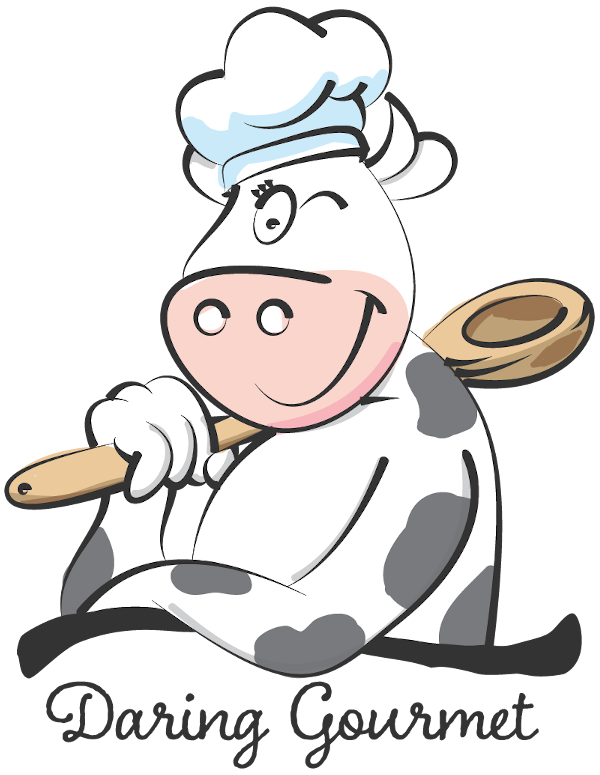
















I cannot wait to try these. My husband and I don’t eat white flour. Can a basic pasta recipe using freshly ground wheat work?
Thanks for posting, we miss these after having them in Koblenz!
Hi Debbie, that should work fine. Happy cooking!
Thank you for this recipe for Maultaschen! My brother worked in Stuttgart for 30 years and when I visited him always enjoyed a broth with Maultaschen. Stateside, I searched for a recipe and was never successful. This looks and sounds exactly what I loved when I visited Germany. I can’t wait to prepare and eat this treat!
This recipe sounds authentic. My Dad was a Schwab, but my Mom was from northern Germany, and she learned from his mother how to make these. One of my favorite things!
My question is…if you are planning on frying them in butter, do you need to boil the maultaschen first?
Danke schön!
They’re one of my favorite things too, Sue :) Yes, you still boil them first. And it helps to chill them for a while before frying to firm them up.
We tried the Authentic Swabian Maultaschen and loved it.
Now we would like to try Maultaschen Schweizer Art (Swiss style, which is whole Maultaschen baked with ham and Swiss cheese on top). Do you have a recipe for this style of Maultaschen. I could not find one. I was wondering what type of ham and how is it cut up to put on top and amounts for ham and Swiss cheese )grated or sliced)? Thank you so much!
Fantastic, Laurie, I’m so glad you enjoyed them! Schweizer Art is super easy – simply place the maultaschen in a greased baking dish, lay a slice of smoked ham on top of each Maultaschen (I like to use thicker slices) and sprinkle shredded Swiss cheese on top. How much you use is entirely personal choice – I like to be generous with it :) Then bake uncovered until the cheese is bubbly and lightly browned. Delish!
We made these tonight and, man, were they spot on! Next time I’ll see if I can find slightly thicker wontons and will pack my filling a little more tightly — ours felt a lot lighter than the dense stuff we would get at the Metzgerei in Tübingen. But the flavor was pure nostalgia.
Thank you so much!
Thank you so much, Whitney, I’m glad you enjoyed them!
Hi,
these look great! Can’t wait to try them. However, we have a housemate who’s vegetarian. Is there a vegetarian version of the maultaschen I could make for her?
These look great! I studied abroad in France several years ago, and my then-boyfriend’s mom was from Germany. We would visit his Oma often, and she was the best cook. I remember getting these from the butcher. She’d slice them and cook them with scrambled eggs. I definitely miss all the delicious German foods. I’m now a French and German high school teacher, and plan on incorporating some of these recipes in our cultural lessons. Thank you!
I’ve had it served with a light gravey and onions – do you have that recipe?
Hi Margaret, not specifically for Maultaschen but it would just be a basic white cream sauce.
If you were going to add ground veal, would it be an addition to or a replacement of one of the other meats? Would it be 1/3 veal, 1/3 beef, 1/3 pork, or some other combination? Thanks.
Hi Shirley, yes it would be a replacement and you can use any combination and ratio you like.
selbst gekochte Maultaschen koennen guht gefrohren werden. Ich liebe deine Zugehoerigkeit zu Stuttgart. A Schwob myself I think its great. Was fehlt ist eingemachtes Kalbfleisch. I could contribute. Keep going (from a schwob living in Canada)
Thank you, Bernd :) Yes they do freeze well. The challenge with veal, at least in the U.S., is both the availability and the cost. It’s not the easiest to find and it’s very expensive. Veal does have more of that “melt-in-you-mouth” texture but even without it the Maultaschen filling is fabulous and reminds me of home. We’re going to Germany this coming year and as always I’m looking forward to eating a lot of great Swabian food :)
I made these yesterday and froze them before cooking (I plan to serve for Christmas). A question: Can they be cooked from frozen or should they be defrosted first? I plan to serve with broth, so can I cook them in the broth or should I cook in water, then add hot broth to them when drained. Thanks for the recipe!
Hi Vanessa, you can put the frozen Maultaschen in the broth and cook them directly in it, but if there are any leaks in the seals you’ll end up with some bits of the filling in the soup. If you don’t mind that then no problem but if you do I would cook them in water first and then add the drained Maultaschen to the broth.
My patience has been rewarded. Thank you so much Kimberly for the recipe for Maultaschen. I think I know what I’ll be cooking for dinner in a few days.
You’re very welcome, Gerald, I hope your patience pays off and that you enjoy these – happy cooking! :)
Thank you so much for this recipe, they are worth the time!
Thank you SO MUCH for this recipe! My mother(originally from Stuttgart/Wangen area) born, 1906, used to always make these, especially during Lent, and always served in broth. I loved these growing up, but as I’ve mentioned before, she didn’t write down these recipes. You just kind of watched her while she said to use about this (x amt) of each ingredient, and demonstrate as she went. My sister wrote down what she recalled, and she has since also passed away. I’ve made Maultaschen before, but mostly with only ground beef for the meat, and my dough did not replicate the yummy pockets floating in broth that I recall. I really look forward to trying your recipe, and will likely try it with the wonton wrappers. Mom would definitely approve of the shortcut. I think I’ve mentioned before, that when I asked her how to make the red cabbage to go with sauerbraten, she said, ” They make good stuff in jars these days. It’s too much trouble. I got modern! Just buy it in the store!!” What’s for dinner? Ein gute suppe. This will be great as we roll into Fall and Winter- even here in Southern California.
You’re welcome, Georgette, I hope you enjoy them! That’s really funny about the jarred red cabbage :) It’s true though, the German-made Rotkohl in jars is really good stuff. I still make my homemade Rotkohl when I have time but don’t feel remotely ashamed to open up a jar of it when I don’t ;) Happy Cooking and Guten Appetit!
Wow, thank you for this Kimberly. My husband comes from near Stuttgart and his mum always gave us some Maultaschen when we first arrived there. Now I know how to make it for Wolfgang myself. I hope he loves them. It has been some years since he has had any. Since I have been making your Spaetzle recipe I have had great success. I make up a large supply and freeze some. You have made my husband very happy.
That’s fantastic, Suzanne. I think this will be a wonderful trip down memory lane for both of you. As always, thank you for your kind comments :)
Can i use puff pastry? for this.
Hi Heinz, puff pastry isn’t remotely the same thing. Puff pastry would result in something like a savory turnover or Swabian version of a Cornish Pasty. Maultaschen are like raviolis – they’re filled pasta.
OK, Thank You.
That’s not to say it wouldn’t taste good – I think it would taste excellent – they just wouldn’t be Maultaschen :)
That’s not to say it wouldn’t taste good – I think it would taste excellent – they just wouldn’t be Maultaschen :)